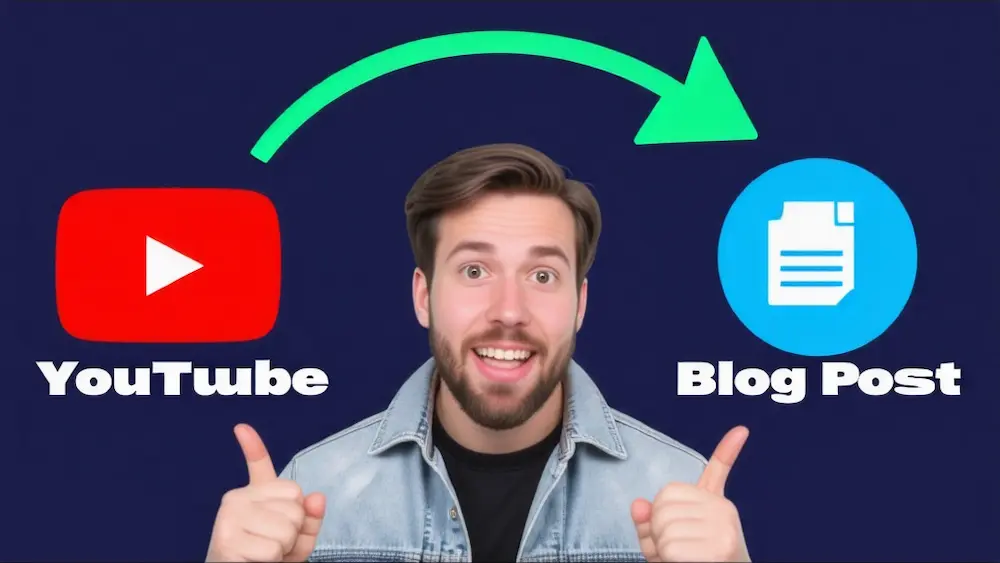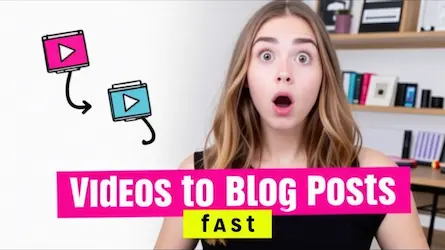How to Transform YouTube Videos into Engaging Blog Posts

Transforming a YouTube video into a published blog post or article has never been easier, thanks to tools like ChatGPT, GPT-4, and Midjourney. Follow this step-by-step guide to accomplish this task in under an hour. Using a video to blog AI tool can significantly streamline this process.
Step 1: Transcribe the YouTube Video
Begin by selecting the YouTube video you want to convert into a blog post. There are two effective methods for transcribing spoken words into text:
Python Script with OpenAI Whisper
Paste the URL of the YouTube video into a script and use OpenAI Whisper to translate the content into text.
Assembly AI API
Utilize the new API from Assembly AI. Paste the YouTube link, select transcription, and it will transcribe the video content in about one minute.
Copy the entire transcript, make necessary adjustments, and save it into an empty text file. This initial step is crucial in the video to blog conversion process.
Step 2: Structure the Blog Post
Next, use GPT-4 or ChatGPT to format the blog post. Plan the structure to include:
- One H1 title
- An introduction
- Two H2 headlines
Generating the H1 Title
Prime ChatGPT with: “You are a creative marketing expert. You will help me write intriguing SEO optimized blog post titles. Acknowledge this with yes.” Then, request it to brainstorm six H1 titles that include the phrase “how to.” For example, “How to Level Up Your Prompt Engineering Skills in Eight Minutes: A Step-by-Step Guide.”
Creating H2 Titles
Provide the transcript to ChatGPT as context and ask it to brainstorm six H2 questions that would be valuable to the reader. Examples include:
- “What are the benefits of adding context to your prompts for ChatGPT?"
- "How can you improve your prompt engineering skills for ChatGPT and GPT-4?”
Step 3: Develop Content for H2 Sections
Prime GPT-4 with: “Ignore all previous instructions. Here is your new role and persona: You are a tech writer for a famous online tech website. Your task is to write engaging and helpful blog posts from the given context. Acknowledge this with answering yes.” After confirmation, provide the context and ask it to write four paragraphs answering the question, “How can you improve your prompt engineering skills for ChatGPT and GPT-4?” Use bullet points and examples for better readability.
Repeat this process for the second H2 question. Leveraging SEO Blogs SaaS tools can also enhance your content strategy.
Step 4: Write the Introduction and Conclusion
Introduction
Ask ChatGPT to draft a short, intriguing introduction using the first-person perspective. For example: “I recently dove into the world of prompt engineering for ChatGPT and GPT-4. I was amazed to find that with just a few simple tweaks, I could dramatically enhance the quality.”
Conclusion
Request ChatGPT to compose an engaging conclusion in the first-person perspective, summarizing the key points. For example: “In just eight minutes, I’ve been able to significantly improve my prompt engineering skills for ChatGPT and GPT-4, and you can too.”
Step 5: Final Edits and Publishing
Review the entire article thoroughly, making personal edits and changes as needed. Run the content through an AI detection tool to ensure quality.
Adding Images
Use Midjourney or other AI image generators to create visuals for the blog post. Generate a Midjourney prompt for an illustration, then run it through Midjourney to select suitable images. Ensure all images have optimized alt texts, for example, “AI tool converting video to blog.”
Final Touches
Include the H1 title, a featured image, introduction, embedded YouTube video, and internal links. Once satisfied with the article, publish it on your website.
By following these steps, you can efficiently transform your video content into a well-structured and engaging blog post. Utilizing video to blog AI tools can make this process smoother and more effective. If you’re a SaaS owner looking to streamline your content creation, consider using VidToBlogs. With VidToBlogs, you can easily turn viral YouTube content into SEO-optimized blog posts that resonate with your target audience. Try VidToBlogs today and elevate your content strategy to the next level!



